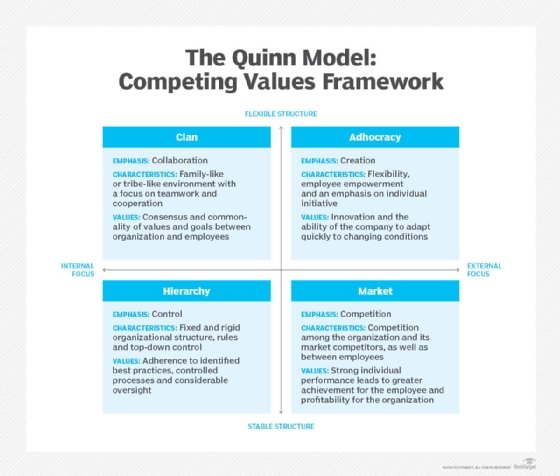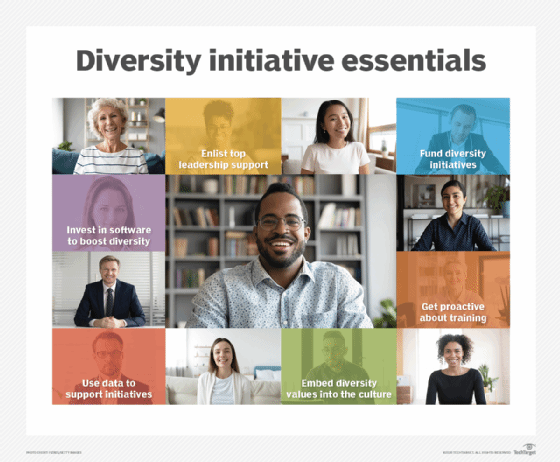
corporate culture
What is corporate culture?
Corporate culture is the collection of values, beliefs, ethics and attitudes that characterize an organization and guide its practices. To some extent, an organization's culture can be articulated in its mission statement or vision statement.
All organizations, whether long-established enterprises, startups, for-profit companies, nonprofit entities or government agencies, have a corporate culture and an opportunity to shape it.
Elements of corporate culture include the organization's physical environment, human resource management practices and staff work habits. Corporate culture is also reflected in the degree of emphasis placed on defining elements, such as hierarchy, process, innovation, collaboration, competition, community involvement and social engagement.
A corporate culture that reflects the broader culture is usually more successful than one at odds with it. For example, in the current global culture that values transparency, equality and communication, a secretive company with a strictly hierarchical structure is likely to have trouble recruiting and retaining workers and also appealing to customers and stakeholders.
However, some organizations create unique cultures that break from certain norms and expected best practices. These types of enterprises are often seen as trailblazers and reap a market advantage.
Corporate culture is sometimes referred to as organizational culture, company culture and workplace culture. However, some experts classify workplace culture as a separate idea that narrowly describes the conditions under which employees conduct their work -- what has come to be referred to, in part, as the employee experience. According to this view, workplace conditions are shaped by and, ultimately, reinforce the overall work culture.
Many organizations determine and then develop the type of corporate culture they want. They formalize it through statements of shared values and policies designed to put those company values in action.
Other organizations see their culture evolve organically and by chance and circumstance. Such organizations may end up with a poor or even toxic culture because they weren't thoughtful or attentive about fostering a more nurturing environment.
An organization's culture determines the way workers behave and what they consider acceptable ways of interacting with each other, business partners and customers. It also determines how the organization reacts to change, evolution and crises and affects the organization's ability to innovate and succeed.
Types of corporate culture
Experts have identified different types of corporate culture and established criteria for classifying them. For example, the authors of a 2018 Harvard Business Review article, "The Leader's Guide to Corporate Culture," built a framework based on a horizontal axis for how people interact that runs from independence to interdependence and a vertical axis for how people respond to change, going from flexibility at the top to stability at the bottom.
The article listed two types of cultures in each of the quadrants. Starting in the upper-right quadrant and moving clockwise, they are the following:
- Purpose and caring in the quadrant for flexibility and interdependence.
- Order and safety in the quadrant for interdependence and stability.
- Authority and results in the quadrant for stability and independence.
- Enjoyment and learning in the quadrant for independence and flexibility.
The authors described each of the eight classifications in depth. For example, they said a caring culture focuses on relationships and mutual trust, while a culture of authority is defined by strength, decisiveness and boldness.
The authors cited online retailer Zappos as exemplifying a culture of enjoyment, the grocery chain Whole Foods as a culture of purpose and Disney as one of caring. Meanwhile, financial firm Lloyd's of London maintains a culture of safety, and pharmaceutical company GSK has a results-oriented culture.
In contrast, University of Michigan professors Robert Quinn and Kim Cameron identified the following four types of corporate cultures:
- Clan culture. The organization has a familylike atmosphere with a focus on mentoring, nurturing, teamwork and togetherness. The organization and its employees concur on core values and goals.
- Adhocracy culture. This is a dynamic and entrepreneurial approach that values risk-taking and an innovation culture. An emphasis on flexibility means employees can create their own initiatives and adapt quickly to changing conditions.
- Market culture. This results-oriented approach values competition and achievement. Employees are expected to adopt a competitive mindset and focus on achieving strong individual performance that maximizes profitability for their organization.
- Hierarchy culture. This approach uses structures and controls to ensure efficiency and stability. Employees must adhere to established best practices, and processes are controlled in a top-down fashion.
Other classifications of corporate cultures include one described as elite for its focus on high-achieving talent and trailblazing achievements. Another is called horizontal, with its collaborative, nonhierarchical structure. And a third alternative is labeled conventional, with traditional hierarchies and dress codes that reinforce a risk-averse approach.

What shapes an organization's culture?
Building and maintaining a corporate culture can happen organically. In such cases, various external and internal factors influence and determine the organization's culture.
For example, the prevailing values of the people in the geographic location where the company is based can filter into the organization. So do the values of the executives, managers and workers. Hiring practices and workplace expectations and habits similarly shape an organization's culture -- for good or bad.
However, organizational leaders who are strategic and seek to cultivate a culture that embodies specific values can do so by implementing policies and procedures that support the culture they desire.
Experts advise such leaders to craft recruitment strategies, hiring practices and personnel policies that can help attract and retain workers who exhibit the values and traits they want in their culture. A company that values customer service might seek to hire people with that skill set in their background or who display a more caring attitude. Hiring managers at an organization with an elite culture might seek out risk-takers. Managers at those companies might also devise perks and incentives that reward employees for taking risks.
Experts also recommend that business leaders establish workplace rules and encourage practices that support the culture they want. Executives who want a collaborative culture might want an open floor plan with flexible seating so workers are free to move around and form teams. Likewise, managers who want a casual corporate culture might want a dress code that reflects that.
Leadership teams and managers must also commit to sustaining a certain type of culture by modeling the expected behaviors and values. They should adjust organizational policies and procedures as needed to support the desired corporate culture, particularly during times of change, such as when integrating an acquired company and its workforce.
The importance of developing a corporate culture
Culture can shape and influence almost all aspects of an organization, including organizational effectiveness, employee well-being and the bottom line.
Researchers have found that organizations with well-conceived cultures supported by good policies attract workers who fit well with the work environment. They have more committed, productive employees.
Business partners, customers and the public often react favorably to companies that are considered to have strong corporate cultures. This can be an important part of an organization's success.
Research has also found that organizations that lack a healthy culture or that have a toxic culture are at higher risk for poor economic results, higher employee turnover and even failure. In fact, experts have found that negative corporate cultures have caused or contributed to criminal corporate activity and other serious problems. For example, the late Edward Kennedy, a longtime U.S. senator from Massachusetts, blamed the implosion of the energy company Enron in 2001 on "a crisis of corporate culture."
How to build a positive corporate culture
Organizations can take specific steps to ensure a positive corporate culture. Steps for doing this include the following:
- Define a successful corporate culture. An organization's leaders must have a clear vision of what attitudes and values they want as part of their corporate culture. This vision differs from organization to organization based on leadership, employees, location, business and many other factors.
- Create goals or milestones. Once business leaders have established their vision, the next step is to implement goals for each team or employee to achieve and policies that guide them. It's imperative to communicate clearly how each employee can support the overall culture.
- Focus on employee engagement. Giving feedback to employees regularly increases the likelihood that they align with these goals. Emphasizing work-life balance, rewarding employees for good performance and achieving certain milestones provide the positive reinforcement needed to build a corporate culture.
- Provide continuous learning and training. Business leaders should implement ongoing training or learning opportunities so employees can improve their performance. An increasingly common approach is to use learning experience platforms to encourage employees to learn new skills and adopt certain values.
The role of diversity, equity and inclusion in corporate culture
Recent history has seen an increased push for diversity, equity and inclusion (DEI) in the workplace. In the U.S., many types of workplace discrimination are prohibited by law. Nevertheless, companies are crafting their own DEI policies and codes of ethics that go beyond what the law requires. Corporate culture plays a significant role in DEI initiatives.
In addition to policymaking, DEI requires building a workforce with members of various ethnicities, backgrounds and perspectives. It also involves ensuring equal access to benefits like fair compensation and advancement opportunities for all employees.
DEI efforts have run into some skepticism, and questions have been raised about whether these policies are the right approach for all organizations. The following are some of the goals DEI strategies aim to achieve:
- Increased innovation resulting from new perspectives. When teams of employees have members with different backgrounds and perspectives who are encouraged to openly share them, a constructive feedback loop can be created. Team members continuously share feedback with each other and introduce new perspectives that contribute to achieving their organization's goals and increasing productivity.
- An expanded customer or client base. An inclusive organization that accommodates varying perspectives is likely to appeal to diverse clients. Business leaders and employees with experiences and perspectives that match their target customers or clients have an easier time connecting with them. This can give an organization a competitive advantage.
- Improved workplace culture. The overall corporate culture can be improved when employees feel a sense of belonging and are able to fulfill their full potential. Real or perceived discrimination can cause a toxic work culture. Also, when employees feel their organization isn't inclusive, they might hesitate to share their views.
- Increased employee retention. Employees are more likely to stay at an organization with an effective DEI strategy that creates a welcoming, inclusive environment.

Examples of successful corporate cultures
Companies that have been recognized for articulating the kind of culture they want and then building their culture to those objectives include the following:
- Adobe. Adobe sets high expectations for its employees but allows them to self-motivate, create their own goals and milestones, and operate without a rating system or micromanagement.
- Google. Google has attributed its focus on creating a fun, collaborative environment as having helped it grow into the tech giant it is today.
- HubSpot. HubSpot's clan culture prioritizes trust and transparency by ensuring employees are regularly informed of company decisions and updates.
- Ikea. The Swedish furniture and home goods retailer has a corporate culture based on equality and inclusiveness. This approach has helped it build a similar reputation among its customers, who often say they value the company and its products for those reasons.
- Netflix. Netflix has a clan or adhocracy culture. Employees are empowered to use whatever means they find necessary for self-development, provided they stay productive.
- SpaceX. SpaceX describes its culture as ambitious and bold, crediting it with helping make SpaceX the first private company to send astronauts to the International Space Station in 2020.
- Zappos. With its taglines "powered by service" and "delivering happiness," Zappos is known for both. It's also known for its use of an open management philosophy called holacracy.
For more on building an effective employee experience strategy, read the following articles:
Workplace transformation: Steps to build a successful plan
3 ways to use AI to improve employee experience
Understand the emerging digital employee experience market
Tap collaboration devices for employee experience data
The link between employee experience and customer experience
History of corporate culture
It's difficult, if not impossible, to establish specifically how the notion of corporate culture first took hold. Some credit Elliott Jaques, a corporate psychologist, researcher and consultant, for identifying the phenomenon and labeling it in his 1951 book, The Changing Culture of a Factory.
The concept of corporate culture, and the study of it, evolved throughout the second half of the 20th century. It was influenced by related academic disciplines, such as business psychology, and societal trends, such as globalism.
During the past several decades, researchers began to study how certain traits influence an organization's overall approach to work, the employees it attracts and public perception of the organization.
Researchers also explored why organizations with certain beliefs and practices tend to fare better on key metrics such as innovation, recruitment, employee retention, public opinion and financial success.
Today, executive advisors, management consultants, business schools and researchers all engage in research to better understand corporate culture. These efforts include what defines and influences an organization's culture and which traits profoundly affect success.
As businesses rush to adopt new technologies in the name of achieving a digital transformation, it's important to remember how important company culture is in this effort. Find out why digital transformation also encompasses culture.